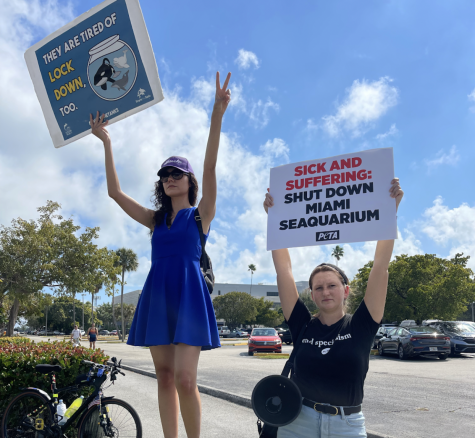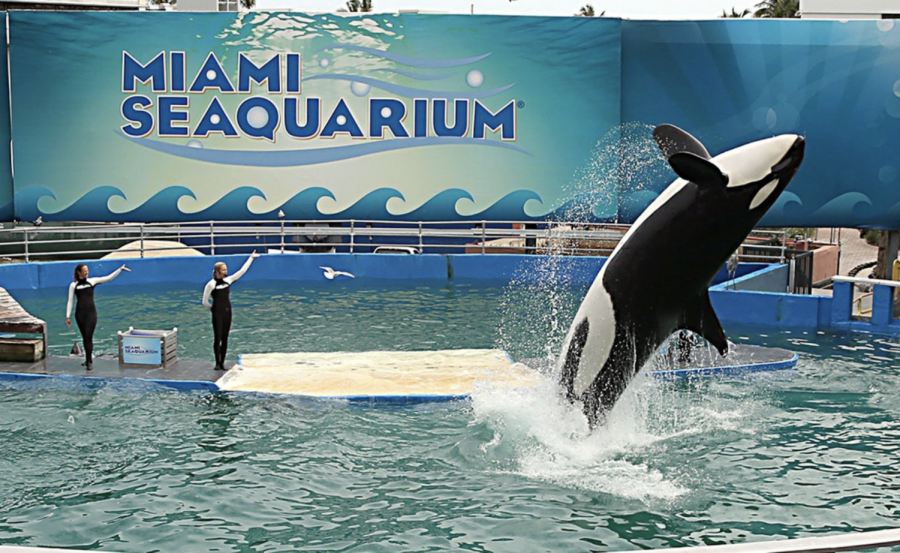The Miami Seaquarium’s Lolita has been performing for 52 years at the local marine tourist attraction. This year, the Seaquarium announced her retirement following a new license with the USDA. (Walter Michot/Miami Herald/TNS)
Special Feature | The Prison Next Door
May 24, 2022
Since early March, the South Florida community has reacted to the disappearance of Lolita, the famous performing orca from the Miami Seaquarium in Key Biscayne. We explain what is known about Lolita’s retirement from shows as well as Lolita’s backstory and perspectives from animal rights activists.
Local Controversy Over “Disappearance” of Miami Seaquarium’s Lolita
For 52 years, families and children shrieked with delight as “Lolita the Killer Whale” made her iconic leap out of the water, splashing audience members in the Key Biscayne sun and gathering cheers with every show.
Now, as of this March, Lolita’s tank is closed to the public and little is known of the famous orca’s condition. Early that month, the Miami Seaquarium announced that it would be ending Lolita’s shows following health concerns and a new license with the United States Department of Agriculture (USDA).
This followed a PETA alert in February that Lolita was suffering from pneumonia, which sparked concern throughout South Florida over the orca’s condition. However, shortly after, the Seaquarium responded with a video of Lolita in her tank, eating and playing with her trainers and seemingly recovering.
The lifespan for an orca in captivity is expected to be up to 45 years, on average. At an elderly 56, Lolita’s advanced age is one factor of the Seaquarium’s decision for her to retire.
“As with any animal who has exceeded their anticipated life span, we will continue to monitor and care for her closely,” the initial Seaquarium statement said, according to NPR.
The most recent update on Lolita’s condition was in late April, when the Seaquarium brought a team of veterinarians to examine the orca to determine whether she can be released back into the wild, for the first time in over half a century.
The recent events that drew national attention to the local Seaquarium follow decades of controversy and concern from animal rights activists, who claim that Lolita’s tank is far too small and that her treatment is inhumane. Activists also raise moral issues regarding her captivity for over half a century, considered the longest period for any orca on Earth. Large organizations, such as PETA, have spoken out on the issue, calling for more transparency from the Seaquarium regarding Lolita’s health and a potential release.
However, another critical aspect of the controversy is Lolita’s originating from the Puget Sound, located in Washington State, where she was known as Tokitae by the Lummi Nation. Members of the Native American community are eager to potentially see the return of the orca, who they consider stolen.
“Let’s bring her home,” Sit Ki Kadem (Doug James), a member of the Lummi Nation, told Fox 13 News Seattle.
As of now, Lolita remains at the Miami Seaquarium under close care. Although the orca’s shows may be missed by members of the South Florida community, many continue to hope for her peaceful retirement.
Seaquarium Orcas’ Northwest Origins
The famous orca of the Seaquarium, Lolita, has not always been a star.
Her origins date back to the Salish Sea outside of Washington State. She lived in a pod of 80 orca whales and was separated from the pod in the 1960s. Soon after, Lolita was sold to the Miami Seaquarium.
The capture of Lolita, originally named Tokitae by the Lummi Nation indigenous people, marked the start of the decline of the orca population. According to thesalishseaschool.org, “The captures in the 70s, (targeting the smaller females and babies), were the beginning of their decline into endangered status. As one might guess, the remaining gene pool drops in diversity with each additional whale lost.”
The remaining survivors of her pod are now located in the Salish Sea Whale Sanctuary. During Lolita’s capture, several whales were killed. Lolita survived the unfortunate events, however, she spent the rest of her time (for now) in captivity at the Seaquarium. Her original home was open and free, keeping her out of any boundaries.
Lolita was not alone in the tank. Hugo was a whale captured from Vaughn Bay in Washington state. According to dolphinproject.com, the website of the Seaquarium’s new owners as of 2022, Lolita and Hugo were put together in a tank where they performed daily shows for visitors. After 12 years, Hugo did not adjust to captivity and bashed his head against the wall of the tank. This caused a fatal brain aneurysm, and Lolita was left in the tank by herself to continue performing.
Lolita was originally under the ownership of the Lummi Nation from her original home. According to earthlawcenter.org, “in 1855, the Lummi Nation signed the Treaty of Point Elliott with the United States, which assured these Native American tribes would have hunting and fishing rights and reservations.”
This gave them the right to protect the orcas in the area including Lolita. They also gave her the name Tokitae, which means “our relations who live under the sea.” Today, animal rights activists and members of the Lummi Nation are calling for Lolita’s potential return to her native habitat.
Activists at the Forefront of the Fight for Lolita’s Freedom
Throughout the last 52 years, the ethical debate of keeping orcas captive in tanks across the United States arose. Many pointed out that these intelligent marine mammals had originally been kidnapped from their pods and sold into captivity, with many orcas being slaughtered in the process of the capture. Throughout the course of several decades, the debate continues to rage onward today. Recently, the story of Lolita, the last living Southern Resident killer whale in captivity, has been at the center of that debate.
“Activists are here protesting today for Lolita, the orca who has been held in the world’s smallest orca tank for over 50 years at Miami Seaquarium. We’ve just learned recently that she’s possibly deathly ill with pneumonia,” explained one out of the many protesters standing outside the parking lot to the Seaquarium in February, hoping to convince potential visitors to turn away. At the time of the protest, Lolita was being treated for a mystery illness. Several unidentified sources claimed that Lolita was suffering from pneumonia.

“[The Seaquarium doesn’t] care about the animals, they only care about profit,” accused the protester.
Local activists arrive to protest the Seaquarium every Sunday from twelve to two. According to this protester, they’ve “only seen the numbers continue to grow for Lolita.”
Many of the local activists had organized either through PETA’s action team or South Florida based animal rights groups on Facebook. The action team was responsible for many of the pamphlets and posters being distributed in the area.
“It’s clear that the people of Miami are ready to see the animals suffering at Miami Seaquarium liberated. We’ve gotten dozens of cars to turn around just today because people are realizing that there’s nothing educational or humane about keeping these very complex intelligent animals in tiny tanks,” added another protester.
Howard Garrett has been the president of Orca Network since forming the organization in 1995. As a researcher and an activist, Garrett has been working with orcas for over 30 years. For many of those years, much of Garrett’s interest has lay regarding Lolita, or Tokitae (meaning nice day, pretty colors) as she was originally named in her native home of the southern Salish Sea.
“I went to Miami and saw her. I’ve grown more respectful of her abilities and courage to stay alive all these years. Lolita has an incredible resilience and some deep resources of strength. I’ve come to appreciate that she is hanging on for some reason.” Garrett explained, recounting his own personal history with Lolita.
“It’s illegal. It’s a tiny tank that violates the animal welfare act in many ways. It’s miserable for her to be there 24/7. It’s the kind of torture that’s comparable to solitary confinement. She needs to come home. Twenty years ago, they admitted that they would have to build a new tank, but they never did,” Garret highlighted much of the abuse that Tokitae has faced, referencing the Seaquarium’s previous unfulfilled promise to build a new tank. However, he is hopeful for the future Tokitae could have.
As explained by Garret, in 2017, the Lummi tribe brought a completely different viewpoint to the table. The tribe passed a resolution explaining their dedication to bringing Lolita back, a sacred being they consider more akin to family.
“[The tribe] was thinking of Lolita as family, considering [their] 10,000 year plus history of being on the water. The tribes up here went everywhere by canoe, going 20 miles across the ocean to travel from island to island,” said Garrett.

The Lummi People are the native inhabitants of Washington’s northernmost coast and southern British Columbia. Notably, they are known for their efforts to defend the environment and places considered sacred to them. Historically, many of the Lummi People established villages near the sea while moving according to the seasons.
“The ancestors of southern resident orcas had been here first. They would meet the natives and build up deep relationships as they’d see each other over and over for lifetimes. Lolita is like family to them. She’s their heritage. Their name for orcas is “qw’e lh’ol’ me chen,” meaning ‘our relations who live under the water,'” explained Garrett.
The main argument for Tokitae resides in the desire of many advocacy groups to return her to a sea pen rehabilitation center, where she can rebuild her strength and stamina: something more akin to the environment she would have enjoyed when she was a calf- and less so to her home now, a space that is twenty feet deep at its deepest and at its longest is simply four times the length of her body. In fact, Tokitae’s tank is considered the smallest orca tank in the world.
“She has her own mind, her own creativity. Even to this day I can’t see any sign of mental deterioration. She’s got a sense of who she is. In other caged animals, we see them pace endlessly or sink into a corner and never want to come out. She’s still very active and responsive to affection- a kind voice, it’s a tone of voice that she’ll recognize,” said Garrett.
Garrett emphasizes what he perceived to be Tokitae’s gentle nature; the orca has never been known to hurt or attack any humans.
“I want people to understand that she has a mind of her own. Lolita has a very special intelligence that we don’t understand but it gives her great strength. People have to focus on her capabilities to understand why she is fully capable of coming home,” summarized Garrett.

Sara • May 26, 2022 at 9:49 am
Incredible article guys! Great job
Claudia • May 25, 2022 at 8:45 pm
Absolutely!!
With re- hab and the fact that we know where her family is she can learn to thrive in the wild. Other long time captive dolphins and whales have been released after many years in captivity with success. We need to ensure that J k & L pods have enough food to survive and thrive. To release her so she can potentially struggle with lack of food availability would not be right and needs to be addressed as well.